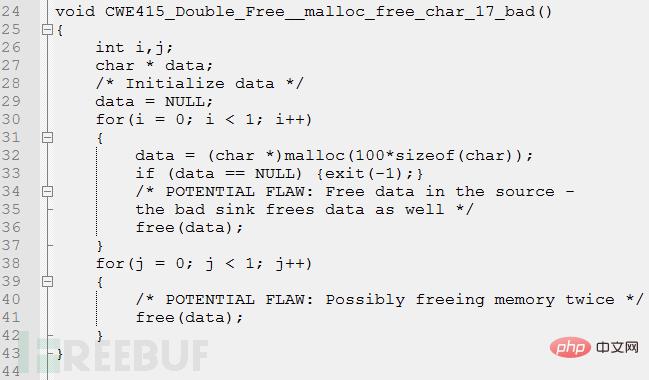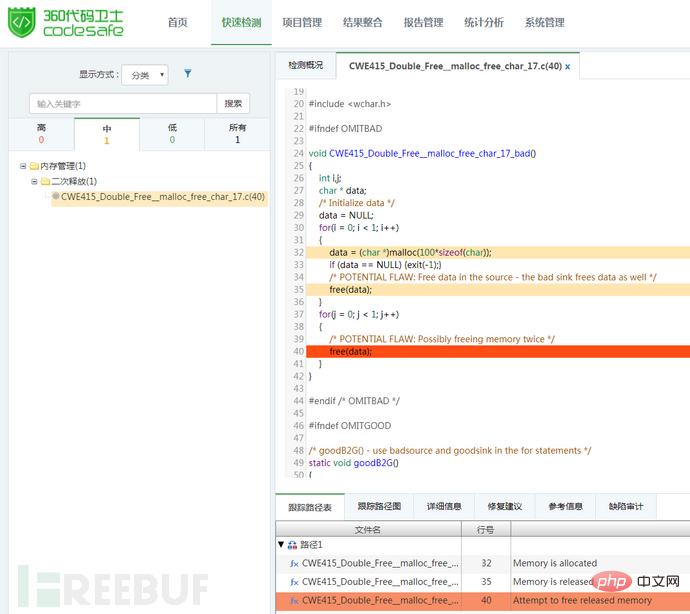 Operation and Maintenance
Operation and Maintenance
 Safety
Safety
 What are the dangers of secondary release of C language source code?
What are the dangers of secondary release of C language source code?
What are the dangers of secondary release of C language source code?
1. Secondary release
The simple understanding of secondary release is that the memory pointed to by the same pointer is released twice. For C language source code, the same pointer is released twice. A free() operation may result in a secondary release. The defective code in Chapter 3.1 of this article describes this type of situation. In C language, improper shallow copy operation is one of the common causes of secondary release. For example: calling the assignment operator or copy constructor once will cause the data members of the two objects to point to the same dynamic memory. At this time, the reference counting mechanism becomes very important. When the reference counting is improper and an object goes out of scope, the destructor will release the memory shared by the two objects. The corresponding data member in another object will point to the memory address that has been released. When this object also goes out of scope, its destructor tries to release the memory again, causing a secondary release problem. Please see CWE ID 415: Double Free for details.
2. The harm of secondary release
Second release of memory may lead to application crashes, denial of service attacks and other problems. It is one of the common vulnerabilities in C/C one. From January to November 2018, there were a total of 38 vulnerability information related to it in CVE. Some of the vulnerabilities are as follows:
| Overview | |
|---|---|
| The 'defaultaddmessage' function of the read-catalog.c file in GNU gettext version 0.19.8 has a secondary free vulnerability. | |
| Olli Parviainen SoundTouch version 2.0 has a security vulnerability in the WavFileBase class of the WavFile.cpp file. A remote attacker can exploit this vulnerability to cause a denial of service. Service (secondary release). | |
| The 'scpkcs15emuschsminit' function of the libopensc/pkcs15-sc-hsm.c file in versions before OpenSC 0.19.0-rc1 exists twice. release vulnerability. An attacker could exploit this vulnerability to cause a denial of service (application crash) using a specially crafted smart card. | |
| The libelf/elf_end.c file in elfutils version 0.173 has a security issue. A remote attacker can exploit this vulnerability to cause a denial of service (2) release and application crash). |
3. Sample code
The example comes from Samate Juliet Test Suite for C/C v1.3 (https:// samate.nist.gov/SARD/testsuite.php), source file name: CWE415_Double_Free__malloc_free_char_17.c.3.1 Defect code

malloc() is used on line 32 Perform memory allocation and use free() on line 36 to release the allocated memory. In the for loop statement on line 38, the already released memory is released. Memory data was released once, causing a secondary release problem.

3.2 Repair code

malloc() on line 32 for memory allocation, and on line 36 Use free() to release, and the memory will not be released after release.

4. How to avoid secondary release
To avoid secondary release, you need to pay attention to the following points:(1) Wild pointers are one of the important reasons for secondary release and use after release. Eliminating the effectiveness of wild pointers The way is to set it toNULL
(2) For the secondary release problem caused by C shallow copy, always performing deep copy is a good solution. (3) Using source code static analysis tools, you can automatically discover possible secondary release problems in the program.immediately after releasing the pointer or set it to point to another legal object.
The above is the detailed content of What are the dangers of secondary release of C language source code?. For more information, please follow other related articles on the PHP Chinese website!

Hot AI Tools

Undresser.AI Undress
AI-powered app for creating realistic nude photos

AI Clothes Remover
Online AI tool for removing clothes from photos.

Undress AI Tool
Undress images for free

Clothoff.io
AI clothes remover

AI Hentai Generator
Generate AI Hentai for free.

Hot Article

Hot Tools

Notepad++7.3.1
Easy-to-use and free code editor

SublimeText3 Chinese version
Chinese version, very easy to use

Zend Studio 13.0.1
Powerful PHP integrated development environment

Dreamweaver CS6
Visual web development tools

SublimeText3 Mac version
God-level code editing software (SublimeText3)

Hot Topics
 1377
1377
 52
52
 C language data structure: data representation and operation of trees and graphs
Apr 04, 2025 am 11:18 AM
C language data structure: data representation and operation of trees and graphs
Apr 04, 2025 am 11:18 AM
C language data structure: The data representation of the tree and graph is a hierarchical data structure consisting of nodes. Each node contains a data element and a pointer to its child nodes. The binary tree is a special type of tree. Each node has at most two child nodes. The data represents structTreeNode{intdata;structTreeNode*left;structTreeNode*right;}; Operation creates a tree traversal tree (predecision, in-order, and later order) search tree insertion node deletes node graph is a collection of data structures, where elements are vertices, and they can be connected together through edges with right or unrighted data representing neighbors.
 The truth behind the C language file operation problem
Apr 04, 2025 am 11:24 AM
The truth behind the C language file operation problem
Apr 04, 2025 am 11:24 AM
The truth about file operation problems: file opening failed: insufficient permissions, wrong paths, and file occupied. Data writing failed: the buffer is full, the file is not writable, and the disk space is insufficient. Other FAQs: slow file traversal, incorrect text file encoding, and binary file reading errors.
 How to output a countdown in C language
Apr 04, 2025 am 08:54 AM
How to output a countdown in C language
Apr 04, 2025 am 08:54 AM
How to output a countdown in C? Answer: Use loop statements. Steps: 1. Define the variable n and store the countdown number to output; 2. Use the while loop to continuously print n until n is less than 1; 3. In the loop body, print out the value of n; 4. At the end of the loop, subtract n by 1 to output the next smaller reciprocal.
 C language multithreaded programming: a beginner's guide and troubleshooting
Apr 04, 2025 am 10:15 AM
C language multithreaded programming: a beginner's guide and troubleshooting
Apr 04, 2025 am 10:15 AM
C language multithreading programming guide: Creating threads: Use the pthread_create() function to specify thread ID, properties, and thread functions. Thread synchronization: Prevent data competition through mutexes, semaphores, and conditional variables. Practical case: Use multi-threading to calculate the Fibonacci number, assign tasks to multiple threads and synchronize the results. Troubleshooting: Solve problems such as program crashes, thread stop responses, and performance bottlenecks.
 CS-Week 3
Apr 04, 2025 am 06:06 AM
CS-Week 3
Apr 04, 2025 am 06:06 AM
Algorithms are the set of instructions to solve problems, and their execution speed and memory usage vary. In programming, many algorithms are based on data search and sorting. This article will introduce several data retrieval and sorting algorithms. Linear search assumes that there is an array [20,500,10,5,100,1,50] and needs to find the number 50. The linear search algorithm checks each element in the array one by one until the target value is found or the complete array is traversed. The algorithm flowchart is as follows: The pseudo-code for linear search is as follows: Check each element: If the target value is found: Return true Return false C language implementation: #include#includeintmain(void){i
 Concept of c language function
Apr 03, 2025 pm 10:09 PM
Concept of c language function
Apr 03, 2025 pm 10:09 PM
C language functions are reusable code blocks. They receive input, perform operations, and return results, which modularly improves reusability and reduces complexity. The internal mechanism of the function includes parameter passing, function execution, and return values. The entire process involves optimization such as function inline. A good function is written following the principle of single responsibility, small number of parameters, naming specifications, and error handling. Pointers combined with functions can achieve more powerful functions, such as modifying external variable values. Function pointers pass functions as parameters or store addresses, and are used to implement dynamic calls to functions. Understanding function features and techniques is the key to writing efficient, maintainable, and easy to understand C programs.
 C language data structure: the key role of data structures in artificial intelligence
Apr 04, 2025 am 10:45 AM
C language data structure: the key role of data structures in artificial intelligence
Apr 04, 2025 am 10:45 AM
C Language Data Structure: Overview of the Key Role of Data Structure in Artificial Intelligence In the field of artificial intelligence, data structures are crucial to processing large amounts of data. Data structures provide an effective way to organize and manage data, optimize algorithms and improve program efficiency. Common data structures Commonly used data structures in C language include: arrays: a set of consecutively stored data items with the same type. Structure: A data type that organizes different types of data together and gives them a name. Linked List: A linear data structure in which data items are connected together by pointers. Stack: Data structure that follows the last-in first-out (LIFO) principle. Queue: Data structure that follows the first-in first-out (FIFO) principle. Practical case: Adjacent table in graph theory is artificial intelligence
 Troubleshooting tips for processing files in C language
Apr 04, 2025 am 11:15 AM
Troubleshooting tips for processing files in C language
Apr 04, 2025 am 11:15 AM
Troubleshooting Tips for C language processing files When processing files in C language, you may encounter various problems. The following are common problems and corresponding solutions: Problem 1: Cannot open the file code: FILE*fp=fopen("myfile.txt","r");if(fp==NULL){//File opening failed} Reason: File path error File does not exist without file read permission Solution: Check the file path to ensure that the file has check file permission problem 2: File reading failed code: charbuffer[100];size_tread_bytes=fread(buffer,1,siz



